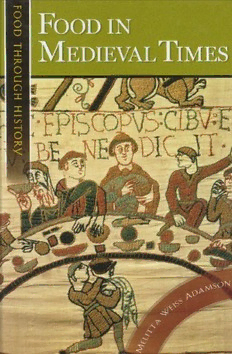
Food in Medieval Times PDF
Preview Food in Medieval Times
Food in Medieval Times Recent Titles in Food through History Food in Early Modern Europe Ken Albala Food in Medieval Times Melitta Weiss Adamson Food through History Greenwood Press Westport, Connecticut • London Library of Congress Cataloging-in-Publication Data Adamson, Melitta Weiss. Food in medieval times / Melitta Weiss Adamson. p. cm.––(Food through history ISSN 1542–8087) Includes bibliographical references and index. ISBN 0–313–32147–7 1. Cookery, Medieval. 2. Cookery––Europe––History. I. Title. II. Series. TX641.A33 2004 641.3´0094´0902––dc22 2004014054 British Library Cataloging in Publication Data is available. Copyright © 2004 by Melitta Weiss Adamson All rights reserved. No portion of this book may be reproduced, by any process or technique, without the express written consent of the publisher. Library of Congress Catalog Card Number: 2004014054 ISBN: 0–313–32147–7 ISSN: 1542–8087 First published in 2004 Greenwood Press, 88 Post Road West, Westport, CT 06881 An imprint of Greenwood Publishing Group, Inc. www.greenwood.com Printed in the United States of America The paper used in this book complies with the Permanent Paper Standard issued by the National Information Standards Organization (Z39.48–1984). 10 9 8 7 6 5 4 3 2 1 CONTENTS Acknowledgments vii Timeline ix Introduction xvii 1. Foodstuffs 1 Grains 1 Legumes 5 Vegetables 6 Herbs 11 Spices 15 Fruits 19 Nuts 24 Condiments 26 Domestic and Wild Animals 30 Fish 39 Dairy Products 45 Beverages 48 2. Food Preparation 55 3. Cuisines by Region 83 Britain 90 France 101 Spain 115 CONTENTS Italy 124 Germany 131 The Low Countries 141 4. Eating Habits and Food Ideas 155 5. Food and Religion 181 6. Concepts of Diet and Nutrition 205 Conclusion 233 Glossary 237 Suggested Further Readings 239 Subject Index 245 Recipe Index 257 vi ACKNOWLEDGMENTS Any book that covers a topic as broad as this depends on the work of more than just one person. First I must thank the generations of scholars who in endless hours unearthed, catalogued, deciphered, transcribed, edited, translated, and analyzed all the different sources, and brought to light a wealth of information, part of which found its way into the present volume. I must also thank my teachers and col- leagues who over the years have supported me in my research on food and nutrition in the Middle Ages, Helmut Birkhan, Gundolf Keil, Constance Hieatt, Terence Scully, Trude Ehlert, Carole Lambert, Gerhard Jaritz, and many others. They patiently answered my many queries, shared with me published and unpublished material, and gen- erously contributed their time and expertise to various collaborative efforts from which this book benefited greatly. My thanks also go to the University of Western Ontario for foster- ing cross-disciplinary teaching and research, and for granting me a sabbatical in which to finish the book. Thanks too to all the libraries that helped me in my research and allowed me to work with some of their most prized possessions, the original medieval manuscripts. I am especially grateful to the Österreichische Nationalbibliothek in Vienna for permission to use illustrations from its famous manuscript collec- tion in this book. My sincere thanks go to Wendi Schnaufer at Greenwood Press for her enthusiasm, constructive feedback, and especially her patience while the work was in progress. It was a time of unexpected challenges ACKNOWLEDGMENTS in my life, and among those who helped me overcome them were my friends Susan, Cécile, Kathy, Angela, Laurence, Frank, Ina, and Jing. Thank you all. Finally, I wish to thank my family, who put up with me during all those months when my mind was elsewhere. Special thanks go to my husband Alan, whose moral support and computer expertise were as invaluable as ever. viii TIMELINE 541 The Roman-Byzantine world is in the grips of the Great (bubonic) Plague of Justinian that brings farming to a halt and causes famine in Europe, the Middle East, and Asia. It is to last for nearly 70 years. 550–650 A new, lightweight plow equipped with a coulter (knife blade) and pulled by eight oxen is invented by the Slavs. The new agriculture leads to a population explosion in northern and western Europe. 610 A new faith, to be called Islam, is preached secretly by the prophet Muhammad. 629 The sharia, a complex legal system, is recognized by Muslims. Pork, animals of prey, and intoxicating bever- ages are among the foodstuffs Muslims are forbidden to consume. 687 Venice begins its rise to power in the Mediterranean, and elects its first doge (person holding the chief office in the city-state of Venice). 700–800 Oriental spices are introduced by Arab merchants into Mediterranean markets. 711 Arabs and Berbers from North Africa invade the Iberian Peninsula and defeat the Visigoths. New methods in agriculture introduced by them include intensive irriga- tion, the use of animal droppings as fertilizers, im-
